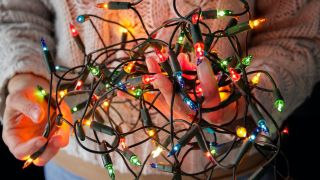Getting into the holiday spirit can be challenging if you’re facing a tangled mess of Christmas lights. It seems that no matter how neatly these twinkling strands are packed away each winter, they somehow end up in a ball of torment the following holiday season. So what causes this mangled mess?
In 2007, researchers published a study in the journal Proceedings of the National Academy of Sciences (opens in new tab) (PNAS) explaining what causes this headache-inducing phenomenon. For the experiment, they put varying lengths of string inside a box and mechanically shook it so that the strings would get tossed around like a load of laundry in the dryer. They repeated the process more than 3,400 times and noticed that knots began forming within seconds of the box being rotated. Throughout the experiment, more than 120 types of knots formed.
“It didn’t take very long for the knots to form — maybe about 10 seconds. We were surprised by that,” study co-author Douglas Smith (opens in new tab), a professor in the Department of Physics at the University of California, San Diego (UCSD), told Live Science. “We immediately started seeing these complicated knots begin to form. It was all very rapid.”
The researchers also learned that the length of the string affected the likelihood of knots forming. Not surprisingly, as the length of the string increased (the longest length used in the study was 15 feet, or 4.6 meters), the probability of a knot appearing also rose, eventually becoming 100% guaranteed. The material the string was made of also had an effect, with more flexible strings experiencing more gnarls compared with rigid strings, according to the study.
Related: Why is Christmas celebrated on Dec. 25?
But perhaps the most important factor leading to the knots was whether the ends of the strings were loose, allowing them to move freely to form tangles.
“The ends are really what get a knot to form,” Dorian Raymer (opens in new tab), the study’s lead author and a former UCSD student who now works as a consulting systems engineer, told Live Science. “Sailors probably know it best, that you have to control what the ends [of a rope] are doing to avoid knots. Otherwise, the ends can move over or under other sections of the string, which will ultimately lead to knots.”
And in the case of Christmas lights, having dozens of light bulbs sticking out from the cord introduces even more opportunities for tangles.
“I think personally from my own experience using Christmas lights, it’s more of the nubs of lights that stick out of the side of the cord that create a lot of friction and get caught on each other,” Smith said. “It’s even worse than a regular piece of string.”
So, what can you do to prevent knots from hijacking the holiday cheer? One popular hack is to wrap the lights around a flat piece of cardboard before storing them in a closed container.
“Make sure to tape down the ends of the lights onto the cardboard,” Raymer said. “This way, you immobilize them, and they won’t be loose and flap around.”
Smith agreed, adding, “Or have someone else hang them up for you.”
Hits: 0










